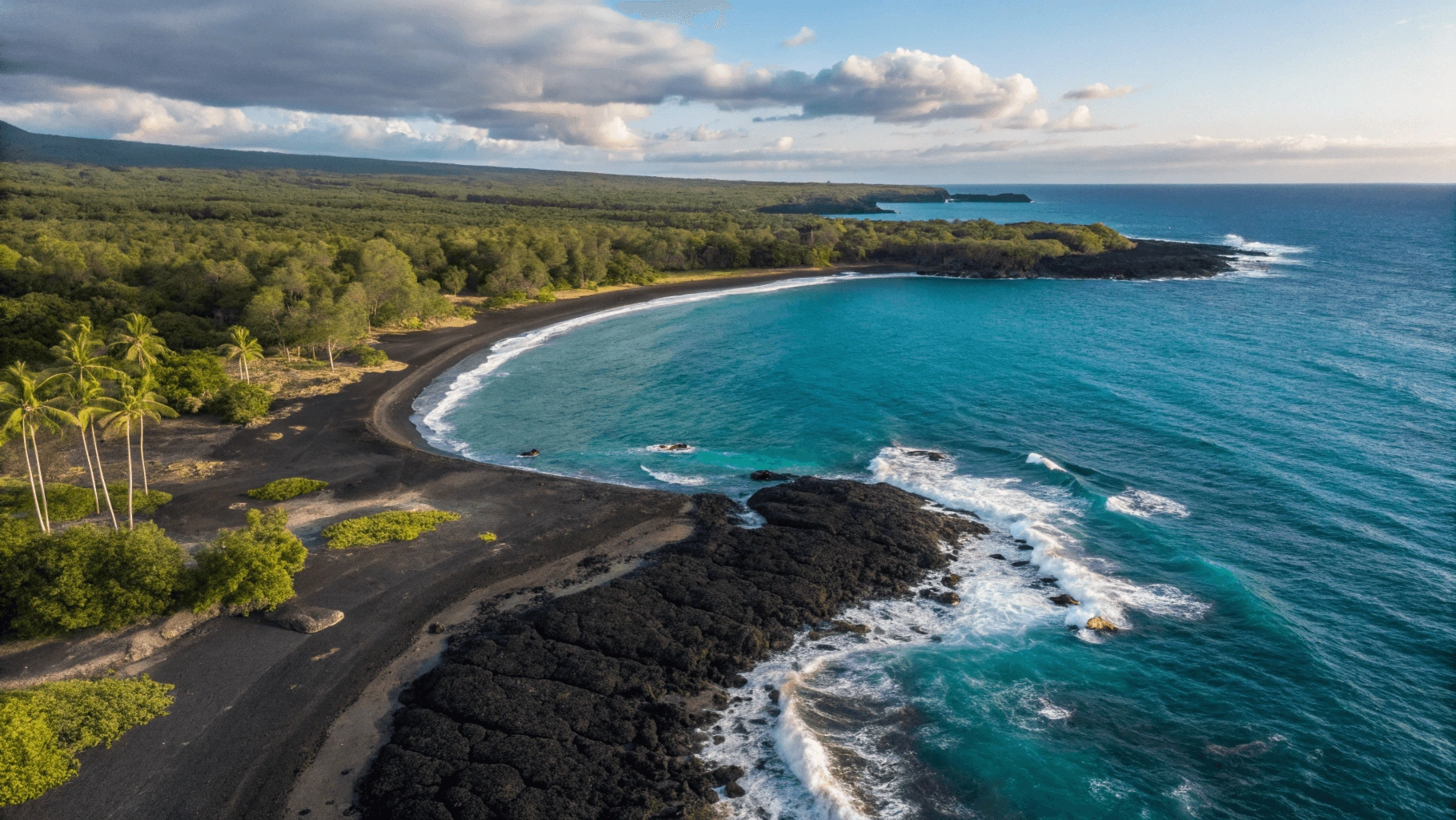Introduction
Nestled along the stunning Kohala Coast of Hawaii’s Big Island lies a hidden gem that combines exclusivity with natural beauty: 49 Black Sand Beach, officially known as Honoka’ope Beach. As frequent Big Island explorers who have visited this coastal treasure multiple times over the years, we’re excited to share our comprehensive guide to this unique destination.
Unlike the more famous jet-black shores of Punalu’u, this beach offers a mesmerizing mix of dark volcanic sand and coral fragments, creating an unforgettable contrast against the vibrant turquoise waters of the Pacific. While getting here requires some insider knowledge (which we’ll detail below), the reward is a less crowded beach experience that showcases the Big Island’s volcanic heritage alongside world-class snorkeling opportunities. For a broader look at Hawaii’s volcanic beaches, check out the Hawai’i Tourism Authority’s overview of black sand beaches for insights into their geological origins and cultural significance.
In this complete 2025 guide, we’ll cover everything from precise access directions and parking tips to the best snorkeling spots and what to pack for your visit. Whether you’re a first-time visitor to the Big Island or a returning traveler looking to explore beyond the standard tourist spots, this insider’s guide will help you experience one of Hawaii’s most distinctive beaches.
Table of Contents

Quick Facts: 49 Black Sand Beach
| Detail | Information |
|---|---|
| Official Name | Honoka’ope Beach |
| Nickname | 49 Black Sand Beach |
| Location | Mauna Lani Resort Area, Kohala Coast, Big Island, Hawaii |
| Access | Via public shore access path (moderate difficulty, adds to exclusivity) |
| Sand Type | Mix of black lava sand with coral and shell fragments (not pure black like Punalu’u) |
| Best For | Snorkeling, sunbathing, photography, relative seclusion |
| Facilities | None directly at the beach (nearest at Mauna Lani Shops) |
| Parking | Limited public parking (12 spaces) |
| Key Feature | Striking visual contrast, excellent snorkeling, semi-private feeling |
What Makes 49 Black Sand Beach Special?
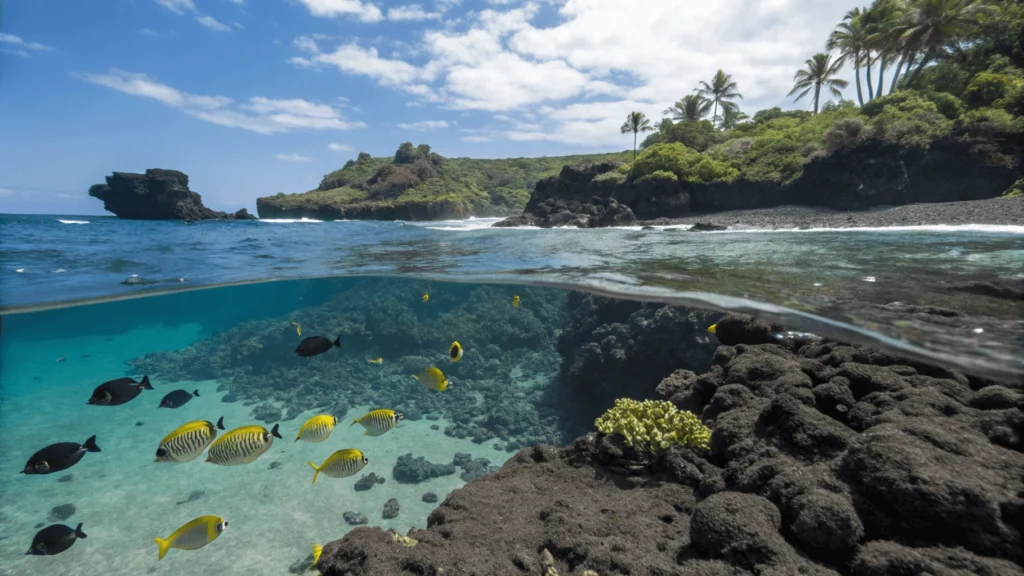
The Unique Sand
What immediately distinguishes Honoka’ope Beach is its distinctive sand composition. Unlike Punalu’u Beach—which features the iconic jet-black sand that most visitors picture when thinking of Hawaii’s volcanic beaches—49 Black Sand Beach offers a more nuanced experience. Here, the sand consists of a fascinating mix of fine black volcanic particles interspersed with fragments of white coral and shells, creating a salt-and-pepper effect that shifts in pattern as the waves wash over the shore.
This texture is not only visually unique but also tells the geological story of the Big Island—where the destructive and creative forces of volcanoes meet the living coral reef ecosystems. The sand feels different underfoot compared to typical beaches, slightly coarser but still comfortable for barefoot walking and sunbathing. Learn more about how black sand forms from lava and marine erosion in this USGS explainer on Hawaii’s volcanic beaches.
Stunning Visuals
The visual appeal of 49 Black Sand Beach extends far beyond its distinctive shoreline. The striking contrast between the dark sand, crystal-clear turquoise waters, verdant coastal vegetation, and dramatic lava rock formations creates a photographer’s paradise. On clear days, you might even catch glimpses of Maui in the distance across the channel, adding another layer to the beach’s scenic panorama.
The beach curves gently for approximately a quarter-mile, flanked by natural lava rock outcroppings that create semi-private coves at either end. The backdrop of swaying palm trees and native coastal plants completes the quintessential Hawaiian beach scene—but with that unique dark sand twist that makes for unforgettable photos.
Exclusivity & Seclusion
Part of what preserves 49 Black Sand Beach’s charm is its somewhat challenging access. Located within the upscale Mauna Lani Resort area, the beach feels more secluded than many of Hawaii’s more accessible shores. While it is absolutely a public beach (as are all Hawaii beaches by law), the limited parking and resort-adjacent location mean you’ll generally share this paradise with fewer people than at beaches like Hapuna or Anaehoomalu Bay.
Even during peak tourist seasons, arriving early often rewards visitors with stretches of beach where you can spread out and enjoy relative privacy. This semi-exclusive atmosphere allows for a more peaceful connection with Hawaii’s natural beauty—though we should note that on weekends and holidays, the beach can still attract a fair number of visitors in the know.
Snorkeling Paradise
While the unique sand and setting might initially draw visitors, many consider the underwater experience to be Honoka’ope’s greatest treasure. The beach features a vibrant reef system with numerous fish species, making it one of the Kohala Coast’s premier snorkeling destinations.
Large lava rock formations extend into the water, creating natural habitats for tropical fish, and the protected coves at either end of the beach offer ideal entry points for snorkelers of various experience levels. Unlike some more crowded snorkeling spots on the island, here you can often enjoy close encounters with Hawaii’s marine life without bumping into other swimmers.
Getting There: Detailed Access Instructions
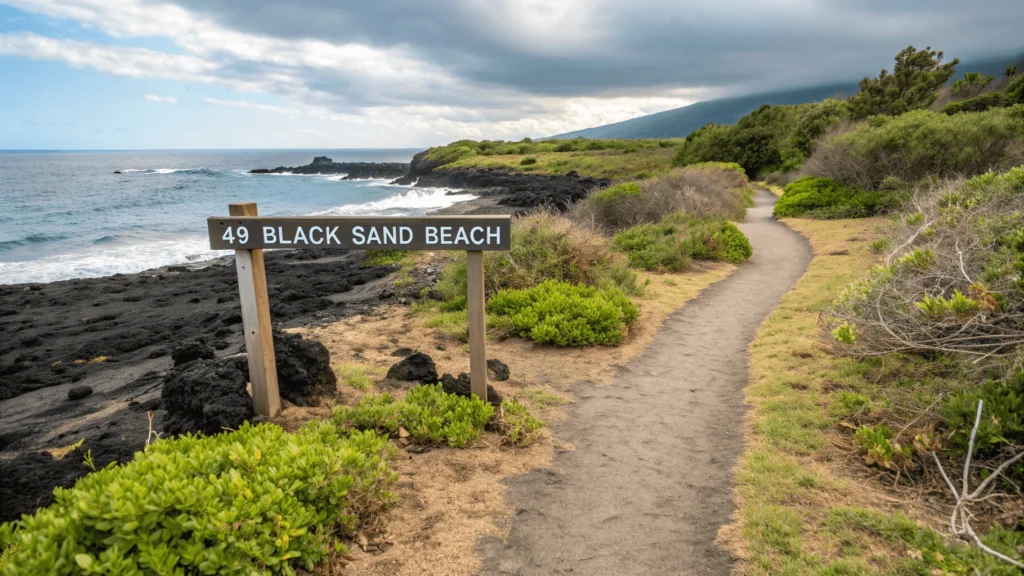
Finding 49 Black Sand Beach can be challenging for first-time visitors, which is precisely why we’re providing these detailed directions. The slightly complicated access is actually part of what keeps this beach special and less crowded.
Driving Directions
From Kona (30-40 minutes):
- Head north on Queen Ka’ahumanu Highway (Highway 19)
- Continue approximately 23 miles past the Kona Airport
- Turn left at the Mauna Lani Resort entrance (there’s a sign for Mauna Lani Drive)
- Follow Mauna Lani Drive into the resort area
From Waikoloa Village/Resorts (10-15 minutes):
- Head south on Queen Ka’ahumanu Highway (Highway 19)
- After approximately 4 miles, turn right at the Mauna Lani Resort entrance
- Follow Mauna Lani Drive into the resort area
Finding the Public Access
Once you’ve entered the Mauna Lani Resort area, follow these precise steps:
- Continue on Mauna Lani Drive past the Shops at Mauna Lani (on your right)
- At the traffic circle, take the second exit onto Kalahuipua’a Drive
- Continue for about 0.5 miles until you reach a security gate for the Pauoa Beach Club and Residences
- Important: At the gate, inform the security guard you’re going to the “49 Black Sand Beach public access”
- The guard will provide a temporary pass (usually valid for 3 hours)
- After passing through the gate, turn right at the first intersection onto Pauoa Beach Drive
- Follow this road until you see a small sign for “Public Beach Access” on your left
- Turn left into the small public parking area
Local Tip: Be polite and clear with the security guards. Remember that public beach access is guaranteed by Hawaii law, but the path to that beach runs through private property, so respectful behavior helps maintain good relations and continued easy access.
Parking
The public parking lot for 49 Black Sand Beach is quite small, containing only about 12 spaces. This limited capacity is one of the primary reasons the beach remains less crowded than others in the area. For the best chance at securing a spot:
- Arrive before 9 AM, especially during high season (December-April)
- Consider visiting on weekdays rather than weekends
- Have a backup beach plan if the lot is full (nearby Holoholokai Beach Park is a good alternative)
If the designated lot is full, there is unfortunately no legal street parking nearby. The entire area is within a private resort community with strictly enforced parking restrictions.
The Walk
From the parking area to the actual beach:
- Follow the clearly marked shoreline access path heading west
- The trail is approximately 1/4 mile (about 5-7 minutes walking)
- The path is partially paved and then transitions to a natural lava rock trail
- Wear proper footwear as parts of the path can be uneven and hot in the midday sun
- The path is mostly unshaded, so bring sun protection
- You’ll know you’ve arrived when the trail opens up to reveal the distinctive black sand cove
Experiencing 49 Black Sand Beach: What to Do

Snorkeling (In-Depth)
Snorkeling at 49 Black Sand Beach offers some of the best underwater exploration on the Kohala Coast. Here’s everything you need to know to make the most of your snorkeling adventure:
Best Entry Points
The beach offers several entry options depending on your experience level:
- Beginner Snorkelers: The center of the beach typically has the gentlest entry point where the sand slopes gradually into the water. Look for areas with fewer rocks for an easier entrance.
- Experienced Snorkelers: The rocky outcroppings at either end of the beach offer the most spectacular marine life but require careful entry. The northern cove (left when facing the ocean) generally offers the best combination of easy access and abundant fish.
Safety Note: Watch for sea urchins nestled among the rocks! These spiny creatures can cause painful injuries if stepped on. Water shoes can provide additional protection.
Marine Life You’ll Encounter
The waters off 49 Black Sand Beach are home to a diverse array of Hawaiian marine life, including:
- Yellow tang and butterflyfish (school in large numbers near coral formations)
- Humuhumunukunukuapua’a (Hawaii’s state fish with distinctive patterns)
- Moorish idols with their elegant trailing fins
- Parrotfish working on reshaping the reef
- Green sea turtles (honu) often spotted feeding on seaweed near rocky areas
- Occasional sightings of moray eels hiding in rock crevices
- Various types of wrasse, including the colorful Hawaiian cleaner wrasse , You can identify many of these species with help from NOAA’s Hawaiian Reef Creatures ID Guide, which features high-quality illustrations and descriptions.
Water Conditions
- Visibility: Typically excellent (50+ feet) in morning hours before trade winds pick up
- Best conditions: Morning snorkeling (7 AM-11 AM) offers the calmest water and best visibility
- When to avoid: If there’s a high surf advisory for the west-facing shores, consider postponing your visit, as conditions can become dangerous quickly
- Currents: Generally minimal within the cove areas, but always be aware of your surroundings and energy level
Gear Recommendations
- Bring your own snorkeling equipment (no rentals available at the beach)
- Full-face snorkel masks work well for beginners concerned about leakage
- Consider a rash guard or swim shirt for sun protection while in the water
- Reef-safe sunscreen is essential for both your protection and preserving the marine ecosystem
- Underwater camera or waterproof phone case to capture the vibrant fish and potential turtle encounters
Swimming
Swimming at 49 Black Sand Beach offers a refreshing complement to snorkeling, though it comes with a few considerations:
- The beach has a moderate slope that deepens fairly quickly, making it less ideal for young children or hesitant swimmers
- Morning hours typically provide the calmest swimming conditions
- Be aware of occasionally submerged rocks, particularly at the outer edges of the swimming area
- There are no lifeguards on duty, so assess conditions carefully and swim with a buddy
Water temperature at this beach typically ranges from 75-80°F year-round, making it comfortable for extended swimming sessions without a wetsuit.
Sunbathing & Relaxing
The distinctive dark sand creates a unique sunbathing experience:
- The dark sand absorbs more heat than white sand beaches, making it quite hot during midday (consider a beach mat or chair for comfort)
- Several Keawe trees at the back of the beach provide natural shade spots during the hottest parts of the day
- The beach’s orientation provides excellent sun exposure throughout the day
- The ambient sound of waves against the lava rock creates a soothing backdrop for relaxation
- The beach’s relatively secluded nature means less foot traffic and a more peaceful atmosphere than more popular beaches
Photography
49 Black Sand Beach offers exceptional photography opportunities for both amateur and professional photographers:
- Morning Light (7 AM-9 AM): Offers soft, golden illumination that highlights the contrast between the dark sand and blue water
- Midday (10 AM-2 PM): Provides the most vibrant turquoise water colors when the sun is directly overhead
- Late Afternoon (4 PM-6 PM): Creates dramatic shadows from the lava rock formations and warm tones on the sand
- Best Angles: Standing at the northern end looking south captures both the curve of the beach and the distinctive rock formations
- Unique Shots: Close-ups of the sand’s texture, half-submerged in clear water, showcase its unique volcanic-and-coral composition
Exploring
Beyond swimming and snorkeling, take time to explore the full beach area:
- Walk the entire length of the beach (approximately 1/4 mile) to discover smaller coves at either end
- Examine the fascinating lava rock formations that frame the beach, showcasing Hawaii’s volcanic history
- Look for interesting shells and coral fragments mixed into the black sand (but leave them for others to enjoy)
- If tide conditions permit, carefully explore the tide pools that sometimes form at the beach’s northern end
- Spot the native coastal vegetation clinging to life between the harsh oceanfront and resort landscaping
What to Bring (Practical Checklist)

Preparing properly for your visit to 49 Black Sand Beach will significantly enhance your experience. Since there are no facilities directly at the beach, you’ll need to bring everything you might need for the day:
- Snorkel gear (mask, snorkel, fins if you plan to venture further)
- Reef-safe sunscreen (Hawaii law prohibits sunscreens containing oxybenzone and octinoxate)
- Water shoes (protect your feet from hot sand and occasional sharp rocks)
- Beach towels or blanket (the sand can get extremely hot)
- Beach umbrella or pop-up tent (limited natural shade available)
- Plenty of water (at least 1 liter per person per 2 hours)
- Snacks/lunch in sealed containers (no trash cans—pack out everything you bring in)
- Wide-brimmed hat and sunglasses (the sun reflection off water intensifies UV exposure)
- Waterproof case for valuables/phone
- Small first-aid kit (including aloe vera for potential sunburns)
- Beach chairs or sitting mat (optional but comfortable)
- Small cooler with ice packs (no alcohol permitted on public beaches)
- Trash bags to pack out all your waste (leave no trace principle)
- Camera to capture the unique landscape
Best Time to Visit
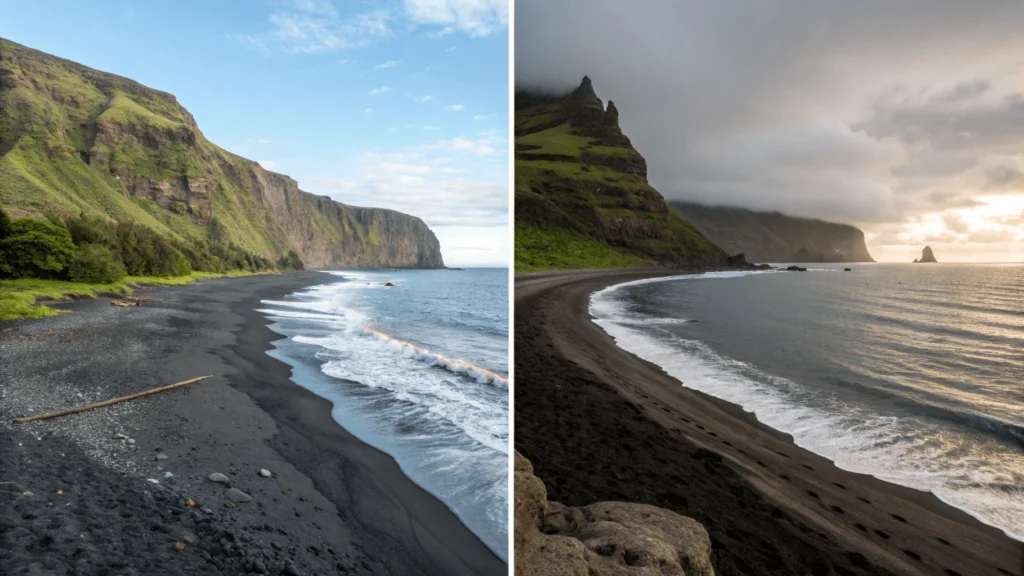
Time of Day
- Early Morning (7 AM-10 AM): Ideal for parking availability, calmest water conditions for snorkeling, comfortable temperatures, and best lighting for photos
- Midday (11 AM-2 PM): Hottest period with most intense sun—beach can be uncomfortably warm but water is refreshing
- Late Afternoon (3 PM-6 PM): Pleasant temperatures return, but afternoon trade winds often create choppier water conditions
Time of Year
- Winter (December-February): Occasionally larger swells can impact swimming conditions, but water remains warm (75°F+); whale watching opportunities from shore
- Spring (March-May): Excellent conditions with decreasing crowds after spring break
- Summer (June-August): Consistent calm water conditions but coincides with peak tourism season
- Fall (September-November): Often the ideal combination of good weather, calmer waters, and fewer tourists
Local Insight: The first two weeks of December and the last two weeks of January typically offer the perfect combination of good weather and minimal crowds.
Beach Etiquette & Safety

Responsible Tourism
- Leave No Trace: Pack out everything you bring to the beach—no trash cans are available
- Preserve the Sand: Taking black sand as a souvenir is both illegal and culturally insensitive
- Protect the Reef: Stand only on sand, never on coral or rock covered with living organisms
- Respect Wildlife: Maintain a legal distance of at least 10 feet from sea turtles and never touch or chase marine life
- Honor Local Culture: The beach and surrounding area hold cultural significance to Native Hawaiians—be respectful of any ceremonies or gatherings
Ocean Safety
- No lifeguards are present—swim at your own risk and know your limitations
- Check current ocean conditions before entering the water
- Be aware of changing tides which can affect swimming conditions throughout the day
- Watch for submerged rocks, particularly during low tide
- Enter and exit the water carefully, especially near rocky areas
- Use the buddy system when snorkeling or swimming
- If caught in a current, swim parallel to shore until free of the current before attempting to swim back to beach
Environmental Protection
- Use only reef-safe sunscreen (free of oxybenzone and octinoxate),To ensure your sunscreen is compliant, refer to the Hawaii Department of Land and Natural Resources’ reef-safe sunscreen guide, which includes a list of approved products and environmental tips.
- Avoid touching or standing on coral, even if it appears dead
- Do not feed fish or other marine life
- Leave rocks, sand, and shells in their natural place
- Stay on established paths to avoid damaging sensitive coastal vegetation
The Story Behind the Name “49 Black Sand Beach”
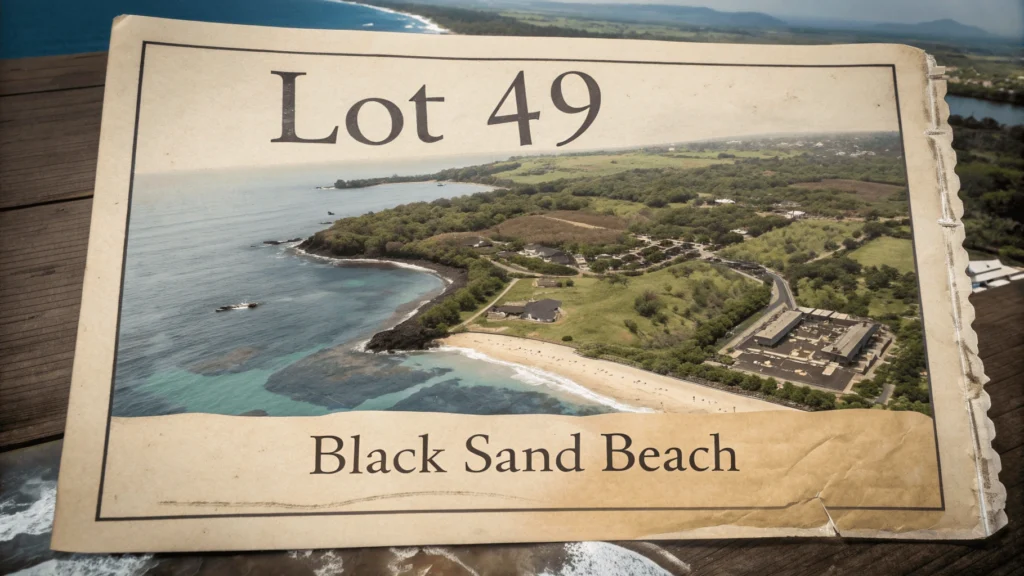
Visitors often wonder about the beach’s numerical nickname. While the official name is Honoka’ope Beach (which roughly translates to “the bending bay”), the more commonly used name “49 Black Sand Beach” has a more recent origin.
According to local sources, the name derives from the development phase of the surrounding Mauna Lani Resort area. The beach was reportedly located near or within lot number 49 on original development maps. Early resort staff and residents began referring to it as “Beach 49” or “49 Beach” as shorthand, and as visitors discovered its distinctive black sand, the full nickname “49 Black Sand Beach” evolved naturally.
Though definitive historical documentation of this naming convention is scarce, the name has stuck and become the primary way even locals refer to this beach. The dual naming reflects Hawaii’s interesting blend of ancient Hawaiian place names and more recent cultural additions.
Brief Geology: Why is the Sand Black(ish)?
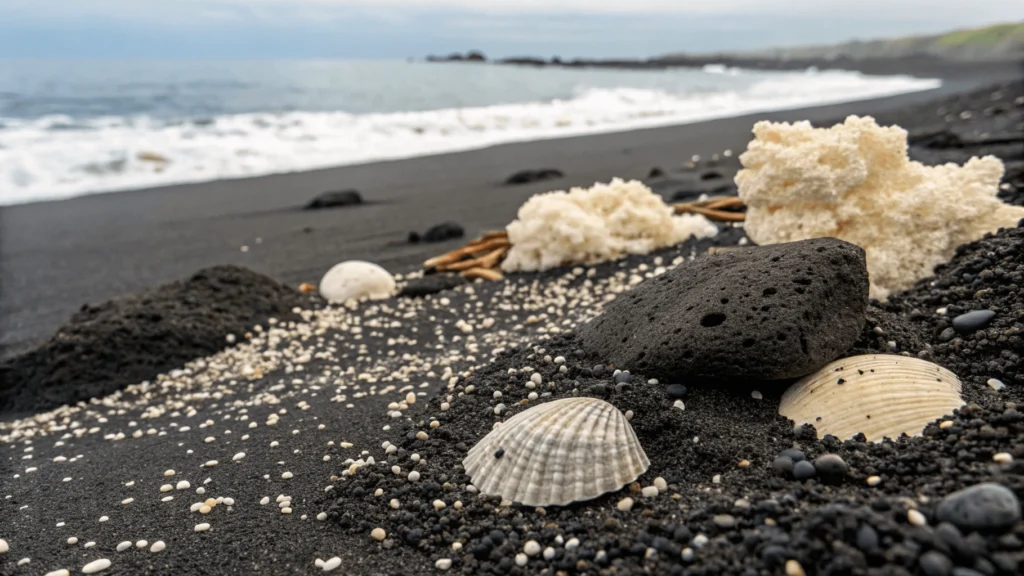
The distinctive coloration of 49 Black Sand Beach tells a fascinating geological story unique to Hawaii. Unlike the white sand beaches found throughout the world (typically composed of crushed coral and shells), black sand beaches are direct evidence of Hawaii’s volcanic origins.
The dark grains at Honoka’ope Beach are primarily composed of basalt—the same rock that makes up much of the Big Island. When lava flows reach the ocean, the extreme temperature difference causes the molten rock to cool instantly and shatter into tiny fragments. Over time, ocean waves gradually break these fragments into increasingly smaller particles, eventually creating the fine black sand that distinguishes this beach.
What makes 49 Black Sand Beach particularly interesting is that it’s not purely black like some other Hawaiian beaches (such as Punalu’u). Instead, it contains a mix of black volcanic particles and white fragments from coral and shells, creating a salt-and-pepper appearance that shifts and changes with the tide. This mixed composition reflects the beach’s location in a transitional zone between active volcanic influence and thriving coral reef ecosystems.
This geological phenomenon serves as a visible reminder of the Big Island’s status as the youngest and still-forming Hawaiian island, where the forces of creation through volcanism and erosion continue to shape the landscape in real time.
Nearby Attractions & Amenities
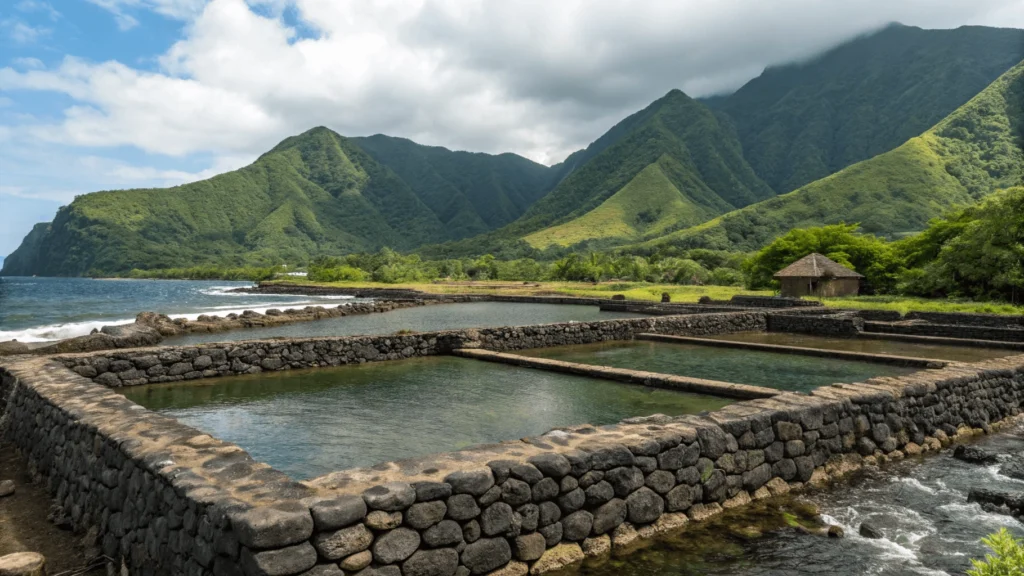
Make the most of your visit to the area by combining your beach trip with these nearby attractions:
Nearby Beaches
- Holoholokai Beach Park (5-minute drive): Beautiful white sand beach with excellent morning snorkeling and petroglyphs trail
- Hapuna Beach State Recreation Area (15-minute drive): Consistently rated among America’s best beaches with expansive white sand and excellent bodyboarding
- Mauna Kea Beach/Kauna’oa Bay (20-minute drive): Crescent-shaped white sand beach with calm waters and manta ray viewing opportunities
Cultural Sites
- Kalahuipua’a Historic Park & Fishponds (5-minute drive): Ancient Hawaiian fishponds and petroglyphs with self-guided tours
- Puako Petroglyph Archaeological Preserve (10-minute drive): One of the largest collections of ancient Hawaiian rock carvings in the state
- Pu’ukohola Heiau National Historic Site (25-minute drive): Impressive temple built by King Kamehameha I
Dining & Shopping
- The Shops at Mauna Lani (5-minute drive): Convenient shopping center with:
- Foodland Farms grocery store (perfect for beach picnic supplies)
- Tommy Bahama Restaurant & Bar
- Under the Bodhi Tree (excellent vegetarian options)
- Island Vintage Coffee
- Several boutique shops and galleries
- Waikoloa Village (15-minute drive): Additional dining and shopping options at Kings’ Shops and Queens’ Marketplace
Practical Amenities
- Public Restrooms: Available at The Shops at Mauna Lani and Holoholokai Beach Park
- Medical Services: North Hawaii Community Hospital in Waimea (25-minute drive)
- Gas Stations: Nearest at Waikoloa Village (15-minute drive)
Frequently Asked Questions
Is 49 Black Sand Beach free to access?
Yes, access is completely free. While you do need to pass through a security gate at a private resort, Hawaii state law guarantees public access to all beaches. There is no entrance fee for the beach itself or for parking.
How hard is it to get to 49 Black Sand Beach?
Moderately challenging but straightforward if you follow directions. The access requires driving through a resort area, passing a security checkpoint (inform them you’re going to the public beach access), finding limited parking, and walking about 1/4 mile on a shoreline path. The extra effort is rewarded with a less crowded beach experience.
Are there restrooms or showers at the beach?
No, there are no facilities directly at the beach. The nearest restrooms are at The Shops at Mauna Lani (about 5 minutes driving from the beach parking lot) or at nearby Holoholokai Beach Park. Plan accordingly and consider a post-beach rinse at your accommodation.
Is 49 Black Sand Beach good for kids?
It depends on the age and swimming ability of the children. The beach has a moderate slope that deepens fairly quickly, and there are some rocks in the water that require careful navigation. It’s better suited for older children who are confident swimmers. For families with young children, the nearby Holoholokai Beach Park offers a more kid-friendly alternative with tidepools.
Can you see turtles at 49 Black Sand Beach?
Yes, green sea turtles (honu) are frequently spotted at this beach. They can often be seen feeding on seaweed near the rocky areas or occasionally basking on the shore. Remember to maintain a legal and respectful distance of at least 10 feet from these protected creatures.
Is the sand really black?
It’s a mix of black and light particles. Unlike Punalu’u Beach (which is famously jet-black), 49 Black Sand Beach features a salt-and-pepper appearance with black volcanic particles mixed with fragments of white coral and shells. The overall effect is distinctly darker than typical beaches but not purely black.
How long can I stay at the beach?
The temporary pass provided at the security gate is typically valid for 3 hours. However, you can request additional time if needed. The beach itself is public, so technically there’s no time limit, but parking restrictions may apply.
Is there cell phone reception at the beach?
Yes, most major carriers have good coverage in this area. The proximity to resort properties ensures relatively reliable service for emergency calls and basic internet usage.
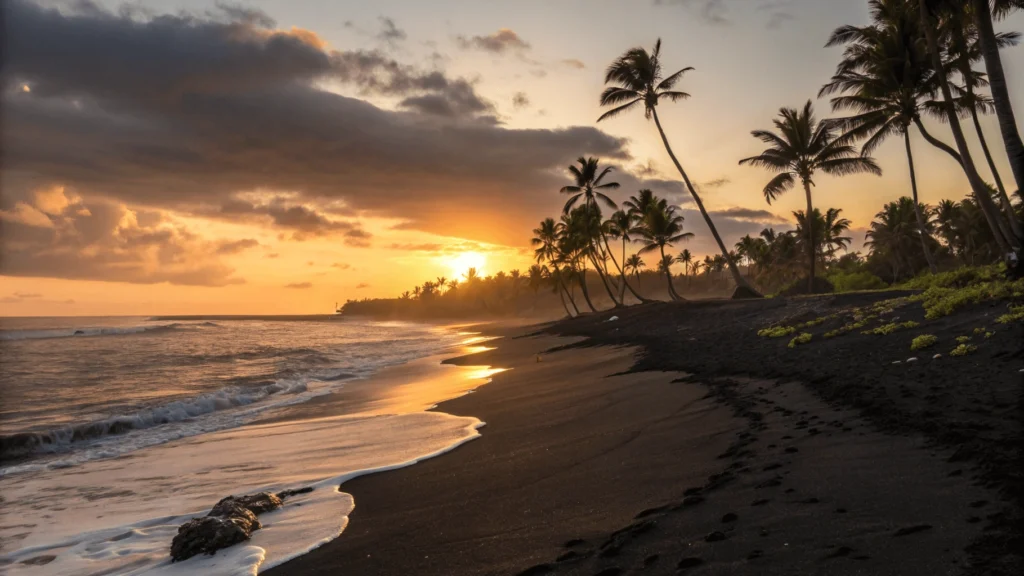
Conclusion
49 Black Sand Beach (Honoka’ope) perfectly encapsulates what makes Hawaii’s Big Island so special—volcanic origins meeting crystal waters, creating something uniquely beautiful that can’t be found in many other places in the world. While reaching this hidden gem requires a bit more effort than some of the island’s more famous beaches, the reward is a distinctive coastal experience that combines natural beauty, excellent snorkeling, and a sense of discovery.
The contrast of dark volcanic sand against turquoise waters creates not just stunning photos but also a tangible connection to the powerful geological forces that continue to shape these islands. As you plan your Big Island adventure, carve out time for this special beach—arrive early, come prepared, and immerse yourself in one of Hawaii’s most distinctive coastal treasures.
Have you visited 49 Black Sand Beach? We’d love to hear about your experience! Share your tips, photos, or questions in the comments section below.
Aloha and happy exploring!

